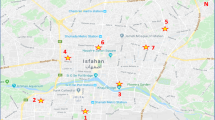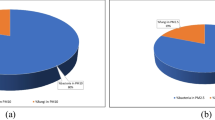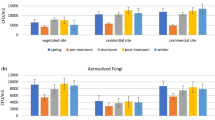Abstract
Aerosol plays a very important role in climate change and public health. It affects cloud condensation nuclei and causes a number of epidemic diseases. The correlations of aerosol with epidemic diseases are due to the biotic components of aerosol. The present study deals with the measurements and characterization of bioaerosol over Indo-Gangetic plain. The levels of PM10 and PM2.5 are much higher than the recommended value set by NAAQS in India. Bacterial and fungal concentrations are in the reported range. Bacterial concentration is higher than fungal concentration. Gram-positive bacteria contribute 75 % while gram-negative bacteria contribute 25 % only. A total seven types of fungi are identified in aerosols. Aspergillus niger is dominant. Meteorological parameters play important roles in growth and presence of microorganism in the air. Bacterial concentrations are governed mainly by temperature while fungal concentration is influenced by relative humidity.



Similar content being viewed by others
References
Amato F, Alastuey A, de la Rosa J, Gonzalez Castanedo Y, Sánchez de la Campa AM, Pandolfi M, Lozano A, Contreras González J, Querol X (2014) Trends of road dust emissions contributions on ambient air particulate levels at rural, urban and industrial sites in southern Spain. Atmos Chem Phys 14:3533–3544
Ariya P, Amyot M (2004) New directions: the role of bioaerosols in atmospheric chemistry and physics. Atmos Environ 38:1231–1232
Battarbee JL, Rose NL, Long X (1997) A continuous, high resolution record of urban airborne particulates suitable for retrospective microscopically analysis. Atmos Environ 31(2):171–181
Bauer H, Kasper-Giebl A, Loflund M, Giebl H, Hitzenberger R, Zibuschka F, Puxbaum H (2002) The contribution of bacterial and fungal spores to the organic carbon content of cloud water, precipitation and aerosols. Atmos Res 64:109–119
Boreson J, Dillner AM, Peccia J (2004) Correlating bioaerosol load with PM2.5 and PM10 concentrations: a comparison between natural desert and urban-fringe aerosols. Atmos Environ 38:6029–6041
Burrows SM, Elbert W, Lawrence MG, Poschl U (2009a) Bacteria in the global atmosphere—part 1: review and synthesis of literature data for different ecosystems. Atmos Chem Phys 9:9263–9280
Burrows SM, Butler T, Jockel P, Tost H, Kerkweg A, Poschl U, Lawrence MG (2009b) Bacteria in the global atmosphere—part 2: modeling of emissions and transport between different ecosystems. Atmos Chem Phys 9:9281–9297
Cullinan P, Cook A, Nieuwenhuijse MJ (2001) Allergen and dust exposure as determinants of work related symptoms and sensitization in a cohort of flour exposed workers; a case–control analysis. Ann Occup Hyg 45:97–103
Despres VR, Huffman JA, Burrows SM, Hoose C, Safatov AS, Buryak G, Frohilic-Nawoisky J, Elbert W, Andreae MO, Poschl U, Jaenicke R (2012) Primary biological aerosol particles in the atmosphere: a review. Tellus B 64:1–58
DI Giorgio C, Krempfe A, Guiraud H, Binder P, Tiret C, Dumenil G (1996) Atmospheric pollution by airborne microorganisms in the city of Marselees. Atmos Environ 30(1):155–160
Flannigan BE, Mc Cabe EM, Mc Garry F (1991) Allergenic and toxigenic microorganisms in houses. J Appl Bacteriol 79:97–103
Jethva H, Satheesh SK, Srinivasan J (2005) Seasonal variability of aerosols over the Indo-Gangetic plains. J Geophys Res 110:D21204
Jones B, Cookson J (1983) Natural atmospheric microbial conditions in a typical suburban area. Appl Environ Microbiol 45:919–934
Jones AM, Harrison RM (2004) The effect of meteorological factors on atmospheric bioaerosol concentrations. Sci Total Environ 326:151–180
Kar J, Deeter MN, Fishman J, Liu Z, Omar A, Creilson JK, Trepte CR, Vaughan MA, Winker DM (2010) Wintertime pollution over the Eastern Indo-Gangetic plains as observed from MOPITT, CALIPSO and tropospheric ozone residual data. Atmos Chem Phys 10:12273–12283
Lee BU, Hong BG, Lee DH, Chong ES, Jung JH, Lee JH, Kim HJ, Lee IS (2012) Bacterial bioaerosol concentrations in public restroom environments. Aerosol Air Qual Res 12:251–255
Li J, Zhuang G, Huang K, Lin Y, Xu C, Yu S (2008) Characteristics and sources of air-borne particulate in Urumqi, China, the upstream area of Asia dust. Atmos Environ 42:776–787
Lin WH, Li CS (2000) Association of fungal aerosols, air pollutants and meteorological factors. Aerosol Sci Technol 32:359–368
Matthias-Maser S, Jaenicke R (1995) The size distribution of primary biological aerosol particles with radii >0.2 μm in an urban/rural influenced region. Atmos Res 39(4):279–286
Miao-Ching C, Chih-Shan L (2007) Fluorochrome in monitoring atmospheric bioaerosols and correlations with meteorological factors and air pollutant. Aerosol Sci Technol 41(7):672–678
Miguel AG, Cass GR, Glovsky MM, Weiss J (1999) Allergens paved road dust and airborne particles. Environ Sci Technol 33:4159–4168
Mohr AJ (2002) Fate and transport of microorganisms in air, chapter 74. In: Hurst CJ, Crawford RL, Knudson G, McInerney M, Stezenbach LD (eds) Manual of environmental microbiology, 2nd edn. ASM Press, Washington DC, pp 827–38
Mouli PC, Mohan SV, Reddy SJ (2005) Assessment of microbial (bacteria) concentrations of ambient air at semi-arid urban region: influence of meteorological factors. Appl Ecol Environ Res 3(2):139–149
Negrin MM, Del Panno MT, Ronco AE (2007) Study of bioaerosols and site influence in the La Plata area (Argentina) using conventional and DNA (fingerprint) based methods. Aerobiologia 23:249–258
Rosas I, Calderon C, Ulloa M, Lackey J (1993) Abundance of airborne Penicillium CFU in relation to urbanisation in Mexico City. Appl Environ Microbiol 59:2648–2652
Schneider NM, Taylor MH, Crary FJ, Trauger JT (1997) On the nature of the brightness asymmetry in the Io torus. J Geophys Res 102(A9):19823–19833
Stetzenbach LD (2005) Bacteriology of air, Topley and Wilsos microbiology and microbial infections: bacteriology-I, 10th edn. In: Borrielo PS, Murray PR, Funke G (eds) ASM Press, Washington, DC, pp 185–194
Thomas RJ, Webber D, Sellors W, Collinge A, Frost A, Stagg AJ, Bailey SC, Jayasekera PN, Taylor RR, Eley S, Titball RW (2008) Characterization and deposition of respirable large- and small-particle bioaerosols. Appl Environ Microbiol 74(20):6437–6443
Tong Y, Lighthart B (1999) Diurnal distribution of total and culturable atmospheric bacteria at a rural site. Aerosol Sci Technol 30:246–254
Tripathi SN, Tare V, Chinnam N, Srivastava AK, Dey S, Agarwal A, Kishore S, Lal RB, Manar M, Kanawade VP, Chauhan SSS, Sharma M, Reddy RR, Rama Gopal K, Narasimhulu K, Reddy LSS, Gupta S, Lal S (2006) Measurements of atmospheric parameters during Indian space research organization geosphere biosphere programme land campaign II at a typical location in the Ganga basin: 1. Physical and optical properties. J Geophys Res 111:D23209
Whitcombe E (2012) Indo-Gangetic river systems, monsoon and malaria. Phil Trans R Soc A 370:2216–2239
Womiloju TO, Miller JD, Mayer PK, Brook JR (2003) Methods to determine the biological composition of particulate matter collected from outdoor air. Atmos Environ 37:4335–4344
Acknowledgments
The authors are grateful to Prof. P.K. Kalra, Director of the Institute, Dr. B.B. Rao, Principal, Technical College, and Prof. D.S. Rao, Head Department of Botany, Faculty of Science of the Institute, for providing the necessary facilities. Financial assistance from the DST (project no. SR/FTP/ES-25/2011), Govt. of India, is gratefully acknowledged. The sampling assistance by Mr. Raju is acknowledged.
Author information
Authors and Affiliations
Corresponding author
Additional information
Responsible editor: Gerhard Lammel
Rights and permissions
About this article
Cite this article
Mamta, Shrivastava, J.N., Satsangi, G.P. et al. Assessment of bioaerosol pollution over Indo-Gangetic plain. Environ Sci Pollut Res 22, 6004–6009 (2015). https://doi.org/10.1007/s11356-014-3776-9
Received:
Accepted:
Published:
Issue Date:
DOI: https://doi.org/10.1007/s11356-014-3776-9




